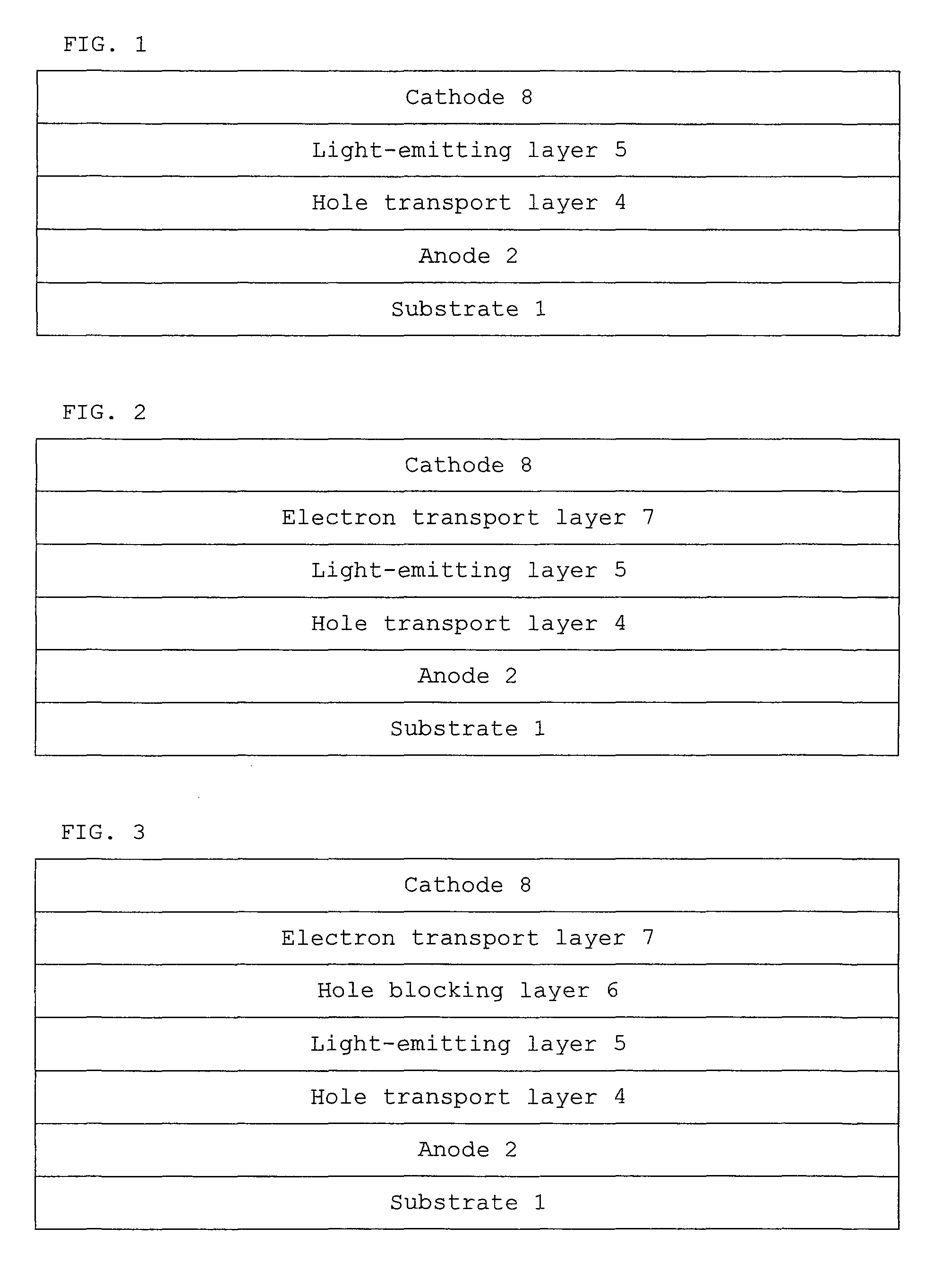Monoamine compound, charge-transporting material, and organic electroluminescent device
a technology of organic electroluminescent devices and monoamine compounds, which is applied in the direction of discharge tube luminescnet screens, natural mineral layered products, etc., can solve the problems of limited application of devices to full-color display use, insufficient luminous efficiency, and present device life, etc., to achieve high efficiency, long life, and high luminance
- Summary
- Abstract
- Description
- Claims
- Application Information
AI Technical Summary
Benefits of technology
Problems solved by technology
Method used
Image
Examples
synthetic example 1
Synthesis of Objective Compounds 1 to 3
[0208]
[0209]Under a nitrogen atmosphere, a mixture of 1,3-dibromobenzene (23 g), 4-biphenylboric acid (21 g), potassium carbonate (40.6 g), tetrakis(triphenylphosphine)palladium (2.0 g), dimethoxyethane (294 ml) and water (147 ml) was stirred for 6 hours while heating under reflux. The resultant reaction mixture was filtrated and subjected to sprinkling washing with ethanol and water to obtain 37 g of a crude product containing the objective compound 1. The objective compound 1 is purified by extraction with chloroform and recrystallization from the crude product.
[0210]In a nitrogen stream, the objective product 1 (7 g), bis(pinacolatodiborone) (6.90 g), potassium acetate (7.55 g) and DMSO (200 ml) were stirred under heating to 60° C. for 15 minutes and [1,1′-bis(diphenylphosphino)ferrocene]dichloropalladium(II) dichloromethane complex (0.555 g) was added thereto, followed by stirring under heating at 80° C. for 8 hours. After cooling to room t...
synthetic example 2
Synthesis of Objective Compounds 4 to 6
[0214]
[0215]In a nitrogen stream, tetrakis(triphenylphosphine)palladium (2.773 g) and an aqueous solution of potassium carbonate (33.17 g) dissolved in water (100 g) were successively added to a mixture of 1,3,5-tribromobenzene (25.18 g), phenylboric acid (21.46 g) and toluene (310 ml), followed by stirring for 9.5 hours while heating under reflux. An organic layer was separated from the resultant solution. After the organic layer was washed with a sodium chloride solution, anhydrous magnesium sulfate and activated clay were added and, after stirring, filtration and concentration were performed. The obtained residue was purified by silica gel column chromatography to obtain an objective compound 4 (14.28 g).
[0216]In a nitrogen stream, a 1.6M of n-butyllithium in n-hexane solution was added dropwise to a mixed solution of the objective compound 4 (9.28 g), anhydrous diethyl ether (75 ml) and anhydrous toluene (50 ml) under a condition of −40 to ...
synthetic example 3
Objective Compounds 7 to 9
[0221]
[0222]Under a nitrogen atmosphere, a mixture of 1,3-dibromobenzene (14.45 g), 3-biphenylboric acid (10 g), potassium carbonate (19.0 g), tetrakis(triphenylphosphine)palladium (0.9 g), toluene (120 ml) and water (60 ml) was stirred for 6 hours while heating under reflux. The organic layer and the aqueous layer of the resultant reaction mixture were separated and the organic layer was washed and concentrated. Thereafter, the concentrate was purified by silica gel column chromatography to obtain an objective compound 7 (8.73 g) as a transparent and colorless liquid.
[0223]
[0224]In a nitrogen stream, the objective product 7 (6.24 g), bis(pinacolatodiborone) (5.65 g), potassium acetate (6.75 g) and DMSO (140 ml) were heated to 60° C., and [1,1′-bis(diphenylphosphino)ferrocene]dichloropalladium(II) dichloromethane complex (0.49 g) was added thereto, followed by stirring under heating at 80° C. for 8 hours. After cooling to room temperature, water (100 ml) an...
PUM
| Property | Measurement | Unit |
|---|---|---|
| glass transition temperature | aaaaa | aaaaa |
| glass transition temperature | aaaaa | aaaaa |
| temperature | aaaaa | aaaaa |
Abstract
Description
Claims
Application Information
 Login to View More
Login to View More - R&D
- Intellectual Property
- Life Sciences
- Materials
- Tech Scout
- Unparalleled Data Quality
- Higher Quality Content
- 60% Fewer Hallucinations
Browse by: Latest US Patents, China's latest patents, Technical Efficacy Thesaurus, Application Domain, Technology Topic, Popular Technical Reports.
© 2025 PatSnap. All rights reserved.Legal|Privacy policy|Modern Slavery Act Transparency Statement|Sitemap|About US| Contact US: help@patsnap.com



